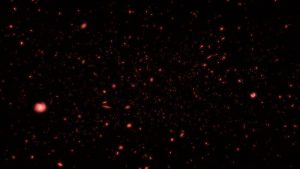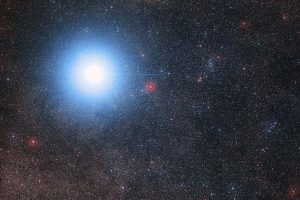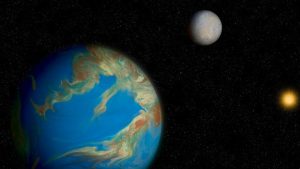Media
Transcript
Once upon a time in the early universe, in theory at least, there was a time when our universe was made of hydrogen, helium, and trace amounts of lithium and beryllium. From this mixture, everything that we see today was formed, and among the first things to form, at least in theory, were stars made only of hydrogen, helium, and those trace amounts of lithium and beryllium. These chemically not-very-diverse stars are called population III stars, and people have been searching for them decades, and the story of when they must have lived and died has gotten more and more confusing the longer we have gone without finding them.

Here’s some background you need for this story to make sense. In general, massive stars live very short lives, and the most massive stars live the most briefly, with some stars counting the years in millions instead of billions. Tiny stars essentially live forever, with their nuclear-burning hearts continuing to churn for trillions of years. Since our universe is aged in the billions and not trillions, we would expect the most massive of the early stars to have died, and then – we used to think – the tiny ones should live on and on and on.
But no matter how hard people look, no proper composition, truly lacking heavy elements, stars have been found. So… we updated our theories. Now we have the added caveat that folks think that stars made of pretty much just H and He must be massive in all cases, and thus short-lived in all cases. This means we are now trying to chase down exactly how massive and how short-lived. Instead of trying to search for old small stars in our current universe, we’re searching for massive stars in time. Thanks to the finite speed of light, this is possible by looking at more and more distant objects whose light has been traveling for ever longer periods of time.
So far, still, no pop III stars have been found, and this is allowing us to narrow in on when they must be. In the latest attempt, astronomers using the Hubble Space Telescope have been unable to find pop III stars in data from when the universe was just 500 million years old. This means all the pop III stars had already formed and gone supernova within 500 million years in the observed systems. This new work was led by the European Space Agency’s Rachana Bhatawdeker and is published in the Monthly Notices of the Royal Astronomical Society based on observations in the direction of galaxy cluster MACSJ0416 taken with Hubble, Spitzer, and the Very Large Telescope.
The target of the observations weren’t the stars in this galaxy cluster, but rather they used this cluster’s gravity as a lens to get a better view of more distant background galaxies that can only be seen when gravity bends light that would otherwise go off in other directions to instead focus in our direction, thus increasing the light we receive from these faint sources. This is a fairly old technique called gravitational lensing, but for this paper, they used new processing methods that allowed them to discover smaller lensed galaxies than have been seen before. It was hoped that these smaller systems might have had slower star formation starts and may still have the elusive pop III stars forming and glowing. This was not found to be the case.
So… we now know with even greater certainty that these stars formed fast and died fast. And, now more than ever, we have to admit our best option for finding them will be the JWST if it ever launches.
Space is hard, and our understanding only advances in two ways – through major breakthroughs that require luck and creativity to recognize, and with the slow and steady advancement of better instruments that allow us to uncover details that had previously been just out of sight. Sometimes, this slow-and-steady progress allows us to discover that the “is that a signal or is that noise” blips in our data are actual signals, and this can be both satisfying and frustrating to folks who have spent years and decades trying to force discoveries out of too small telescopes.

This is the case for the research of Fritz Benedict and Barbara McArthur, who spent decades using the telescopes of McDonald Observatory, the Hubble Space Telescope, and other missions and ground-based systems to try and discover planets by looking for the on-the-sky motions of their stars. This technique has really only become possible now that we have the Gaia space telescope, but I remember hearing talks in grad school where Fritz was able to put limits on “these kinds of planets don’t exist, but these kinds still could be there”. His targets were nearby stars like Bernard’s star and Proxima Centauri. Well, as we discussed recently, the ESPRESSO instrument on the Very Large Telescope has used spectroscopy to determine there are planets. With this high-quality data in hand, Fritz has gone back through 25 years of Hubble data, something that reminded me I am old since I remember the first talks he gave, and in this data, he was able to see these now confirmed worlds in his noise. These were datapoints no one could have used to say “There be planets!”, not by themselves, but they are enough to say now, “We can confirm the orbits with greater precision with this long baseline.” What’s more, with today’s new data, they were able to find a new third planet in this system with an extremely long orbital period and a mass just seven times Earth’s mass. This story once again shows there is no expiry date on data.

In general, we’re pretty much over announcing every new planetary discovery. There are just too many of them, and it’s starting to feel like saying “Hey that star has a planet” is no more exciting than saying “Hey, the Mississippi is flooding” here in Illinois, where the river is over flood stage as often as it isn’t. Sure, there is a weather alert, but does anyone really still care? But just like sometimes the Mississippi is so high everyone needs to sit up and take notice, sometimes a newly discovered world is so special, we need to mention it here. Proxima Centauri makes it in for being the closest star and having a really cool historical story. Now, Kepler 160 and its planet KOI-456.04 are going to also make headlines. In this case, it’s because we actually found a system I’m comfortable calling a “Fat Earth” system. In a new paper in Astronomy & Astrophysics, a team led by Rene Heller announced there is an 85% chance there is a two Earth-mass planet orbiting in the habitable zone of a Sun-like star. With a distance of 3140 ly, we’re not going there anytime soon, but I’d be satisfied with confirmation of this world and knowledge that a fat-Earth is out there giving big beautiful earthy possibilities.
Learn More
Hubble Makes Surprising Find in the Early Universe
- Hubble Space Telescope news release
- “Evolution of the galaxy stellar mass functions and UV luminosity functions at z=6−9 in the Hubble Frontier Fields,” Rachana Bhatawdekar et al., 2019 March 27, Monthly Notices of the Royal Astronomical Society (Preprint on arxiv.org)
- New paper forthcoming from MNRAS
25-Year-Old Hubble Data Confirms Exoplanet Proxima Centauri c
A Mirror Image of Earth and Sun
- Max Planck Institute for Solar System Research press release
- “Transit Least-Squares Survey III. A 1.9 R_Earth Transit Candidate in the Habitable Zone of Kepler-160 and a Nontransiting Planet Characterized by Transit-Timing Variations,” René Heller et al., 2020 June, Astronomy & Astrophysics (Preprint on arxiv.org)
Credits
Written by Pamela Gay
Hosted by Pamela Gay
Audio and Video Editing by Ally Pelphrey
Content Editing by Beth Johnson
Intro and Outro music by Kevin MacLeod, https://incompetech.com/music/


 We record most shows live, on Twitch. Follow us today to get alerts when we go live.
We record most shows live, on Twitch. Follow us today to get alerts when we go live.